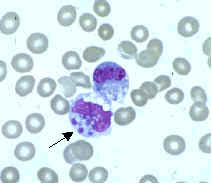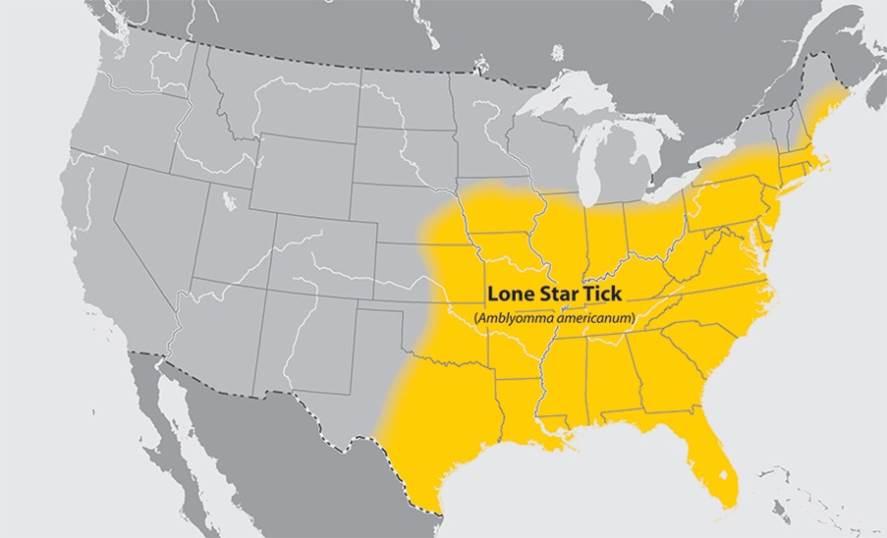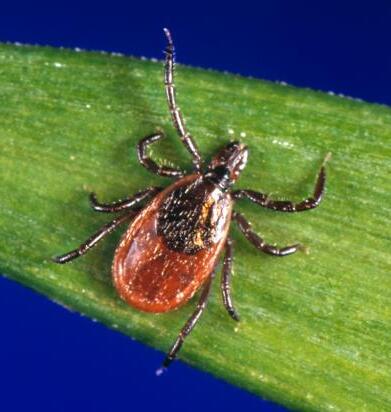|
Ehrlichia Chaffeensis
''Ehrlichia chaffeensis'' is an obligate intracellular, Gram-negative species of Rickettsiales bacteria. It is a zoonotic pathogen transmitted to humans by the Amblyomma americanum, lone star tick (''Amblyomma americanum''). It is the causative agent of human monocytic ehrlichiosis. Genetic studies support the endosymbiotic theory that a subset of these organisms evolved to live inside mammalian cells as mitochondria to provide cellular energy to the cells in return for protection and sustenance. ATP production in the rickettsiae is biochemically identical to that in mammalian mitochondria; all multi-cellular eukaryotes have mitochondria in their cells, including birds, fish, reptiles, invertebrates, plants, and fungi in addition to mammals. Human monocytic ehrlichiosis caused by ''E. chaffeensis'' is known to spread through tick infection primarily in the Southern, South-central and Mid-Atlantic regions of the United States. In recent years, the lone star tick has expanded i ... [...More Info...] [...Related Items...] OR: [Wikipedia] [Google] [Baidu] |
Ehrlichia
''Ehrlichia'' is a genus of Rickettsiales bacteria that are transmitted to vertebrates by ticks. These bacteria cause the disease ehrlichiosis, which is considered zoonotic, because the main reservoirs for the disease are animals. ''Ehrlichia'' species are obligately intracellular pathogens and are transported between cells through the host cell filopodia during initial stages of infection, whereas in the final stages of infection, the pathogen ruptures the host cell membrane. History The genus ''Ehrlichia'' is named after German microbiologist Paul Ehrlich. The first ehrlichial disease was recognized in South Africa during the 19th century. Its tick-borne nature was determined in 1900. The organism itself was demonstrated in 1925 when it was recognized to be a ''Rickettsia''. It was initially named ''Rickettsia ruminantium'', and is currently named ''Ehrlichia ruminantium''. In 1945, an "infection and treatment" method for livestock was developed. This is still the only comme ... [...More Info...] [...Related Items...] OR: [Wikipedia] [Google] [Baidu] |
Bacteria
Bacteria (; singular: bacterium) are ubiquitous, mostly free-living organisms often consisting of one biological cell. They constitute a large domain of prokaryotic microorganisms. Typically a few micrometres in length, bacteria were among the first life forms to appear on Earth, and are present in most of its habitats. Bacteria inhabit soil, water, acidic hot springs, radioactive waste, and the deep biosphere of Earth's crust. Bacteria are vital in many stages of the nutrient cycle by recycling nutrients such as the fixation of nitrogen from the atmosphere. The nutrient cycle includes the decomposition of dead bodies; bacteria are responsible for the putrefaction stage in this process. In the biological communities surrounding hydrothermal vents and cold seeps, extremophile bacteria provide the nutrients needed to sustain life by converting dissolved compounds, such as hydrogen sulphide and methane, to energy. Bacteria also live in symbiotic and parasitic relationsh ... [...More Info...] [...Related Items...] OR: [Wikipedia] [Google] [Baidu] |
Pseudomonadota
Pseudomonadota (synonym Proteobacteria) is a major phylum of Gram-negative bacteria. The renaming of phyla in 2021 remains controversial among microbiologists, many of whom continue to use the earlier names of long standing in the literature. The phylum Proteobacteria includes a wide variety of pathogenic genera, such as ''Escherichia'', '' Salmonella'', ''Vibrio'', ''Yersinia'', ''Legionella'', and many others.Slonczewski JL, Foster JW, Foster E. Microbiology: An Evolving Science 5th Ed. WW Norton & Company; 2020. Others are free-living (nonparasitic) and include many of the bacteria responsible for nitrogen fixation. Carl Woese established this grouping in 1987, calling it informally the "purple bacteria and their relatives". Because of the great diversity of forms found in this group, it was later informally named Proteobacteria, after Proteus, a Greek god of the sea capable of assuming many different shapes (not after the Proteobacteria genus ''Proteus''). In 2021 the Internat ... [...More Info...] [...Related Items...] OR: [Wikipedia] [Google] [Baidu] |
Rickettsiales
The Rickettsiales, informally called rickettsias, are an order of small Alphaproteobacteria. They are obligate intracellular parasites, and some are notable pathogens, including ''Rickettsia'', which causes a variety of diseases in humans, and ''Ehrlichia'', which causes diseases in livestock. Another genus of well-known Rickettsiales is the ''Wolbachia'', which infect about two-thirds of all arthropods and nearly all filarial nematodes. Genetic studies support the endosymbiotic theory according to which mitochondria and related organelles developed from members of this group.Thomas S. (2016). Rickettsiales:Biology, Molecular Biology, Epidemiology, and Vaccine Development. pp.529. Springer• The Rickettsiales are difficult to culture, as they rely on living eukaryotic host cells for their survival. Rickettsiales phylogeny The Rickettsiales further consist of three known families, the Rickettsiaceae, the Midichloriaceae, and the Ehrlichiaceae. Most studies also support the in ... [...More Info...] [...Related Items...] OR: [Wikipedia] [Google] [Baidu] |
Ehrlichiaceae
The Ehrlichiaceae are a family of bacteria, included in the order Rickettsiales The Rickettsiales, informally called rickettsias, are an order of small Alphaproteobacteria. They are obligate intracellular parasites, and some are notable pathogens, including ''Rickettsia'', which causes a variety of diseases in humans, and ' .... References External links * Rickettsiales Bacteria families {{alphaproteobacteria-stub ... [...More Info...] [...Related Items...] OR: [Wikipedia] [Google] [Baidu] |
Bacteria
Bacteria (; singular: bacterium) are ubiquitous, mostly free-living organisms often consisting of one biological cell. They constitute a large domain of prokaryotic microorganisms. Typically a few micrometres in length, bacteria were among the first life forms to appear on Earth, and are present in most of its habitats. Bacteria inhabit soil, water, acidic hot springs, radioactive waste, and the deep biosphere of Earth's crust. Bacteria are vital in many stages of the nutrient cycle by recycling nutrients such as the fixation of nitrogen from the atmosphere. The nutrient cycle includes the decomposition of dead bodies; bacteria are responsible for the putrefaction stage in this process. In the biological communities surrounding hydrothermal vents and cold seeps, extremophile bacteria provide the nutrients needed to sustain life by converting dissolved compounds, such as hydrogen sulphide and methane, to energy. Bacteria also live in symbiotic and parasitic relationsh ... [...More Info...] [...Related Items...] OR: [Wikipedia] [Google] [Baidu] |
Amblyomma Americanum
''Amblyomma americanum'', also known as the lone star tick, the northeastern water tick, or the turkey tick, or the "Cricker Tick", is a type of tick indigenous to much of the eastern United States and Mexico, that bites painlessly and commonly goes unnoticed, remaining attached to its host for as long as seven days until it is fully engorged with blood. It is a member of the phylum Arthropoda, class Arachnida. The adult lone star tick is sexually dimorphic, named for a silvery-white, star-shaped spot or "lone star" present near the center of the posterior portion of the adult female shield (scutum); adult males conversely have varied white streaks or spots around the margins of their shields. ''A. americanum'' is also referred to as the turkey tick in some Midwestern U.S. states, where wild turkeys are a common host for immature ticks. It is the primary vector of ''Ehrlichia chaffeensis'', which causes human monocytic ehrlichiosis, and ''Ehrlichia ewingii'', which causes human a ... [...More Info...] [...Related Items...] OR: [Wikipedia] [Google] [Baidu] |
Human Monocytic Ehrlichiosis
Human monocytotropic ehrlichiosis is a form of ehrlichiosis associated with ''Ehrlichia chaffeensis''. This bacterium is an obligate intracellular pathogen affecting monocytes and macrophages. Symptom and signs The most common symptoms are fever, headache, malaise, and muscle aches ( myalgia). Compared to human granulocytic anaplasmosis, rash is more common. Laboratory abnormalities include thrombocytopenia, leukopenia, and elevated liver tests. The severity of the illness can range from minor or asymptomatic to life-threatening. CNS involvement may occur. A serious septic or toxic shock-like picture can also develop, especially in patients with impaired immunity. Cause This disease is known to be caused by tick bites. Diagnosis Tick exposure is often overlooked. For patients living in high-prevalence areas who spend time outdoors, a high degree of clinical suspicion should be employed. Ehrlichia serologies can be negative in the acute period. Polymerase chain reaction i ... [...More Info...] [...Related Items...] OR: [Wikipedia] [Google] [Baidu] |
Fort Chaffee
Fort Chaffee Joint Maneuver Training Center is an Army National Guard installation in western Arkansas, adjacent to the city of Fort Smith. Established as Camp Chaffee in 1941, renamed to Fort Chaffee in 1956, Fort Chaffee has served as a United States Army base, training camp, prisoner-of-war camp, and refugee camp. The base was closed following the 1995 Base Realignment and Closure Commission round. Since that time, the Arkansas National Guard has been using as a training facility. The State of Arkansas received , about half of which have been redeveloped as of 2014. The main environmental concern has been asbestos, released during various fires. Location Fort Chaffee is just outside Fort Smith (Sebastian County) and Barling (Sebastian County) on Arkansas Highway 22, southeast of Fort Smith Regional Airport. The Arkansas River flows eastward along its northern border and Interstate 40 is to the north on the opposite side of the river. History Foundation Fort Chaffee was ... [...More Info...] [...Related Items...] OR: [Wikipedia] [Google] [Baidu] |
White-tailed Deer
The white-tailed deer (''Odocoileus virginianus''), also known as the whitetail or Virginia deer, is a medium-sized deer native to North America, Central America, and South America as far south as Peru and Bolivia. It has also been introduced to New Zealand, all the Greater Antilles in the Caribbean (Cuba, Jamaica Jamaica (; ) is an island country situated in the Caribbean Sea. Spanning in area, it is the third-largest island of the Greater Antilles and the Caribbean (after Cuba and Hispaniola). Jamaica lies about south of Cuba, and west of His ..., Hispaniola, and Puerto Rico), and some countries in Europe, such as the Czech Republic, Finland, France, Germany, Romania and Serbia. In the Americas, it is the most widely distributed wild ungulate. In North America, the species is widely distributed east of the Rocky Mountains as well as in southwestern Arizona and most of Mexico, except Baja California peninsula, Lower California. It is mostly displaced by the black ... [...More Info...] [...Related Items...] OR: [Wikipedia] [Google] [Baidu] |
Ehrlichiosis
Ehrlichiosis is a Tick-borne disease, tick-borne bacterial infection, caused by bacteria of the family Anaplasmataceae, genera ''Ehrlichia'' and ''Anaplasma''. These Obligate intracellular parasite, obligate intracellular bacteria infect and kill white blood cells. The average reported annual incidence is on the order of 2.3 cases per million people. Types Six (see note below) species have been shown to cause human infection: * ''Anaplasma phagocytophilum'' causes human granulocytic anaplasmosis. ''A. phagocytophilum'' is endemic to New England and the north-central and Pacific regions of the United States. * ''Ehrlichia ewingii'' causes human ewingii ehrlichiosis. ''E. ewingii'' primarily infects deer and dogs (see Ehrlichiosis (canine)). ''E. ewingii'' is most common in the south-central and southeastern states. * ''Ehrlichia chaffeensis'' causes human monocytic ehrlichiosis. ''E. chaffeensis'' is most common in the south-central and southeastern states. * ''Ehrlichia canis'' ... [...More Info...] [...Related Items...] OR: [Wikipedia] [Google] [Baidu] |




